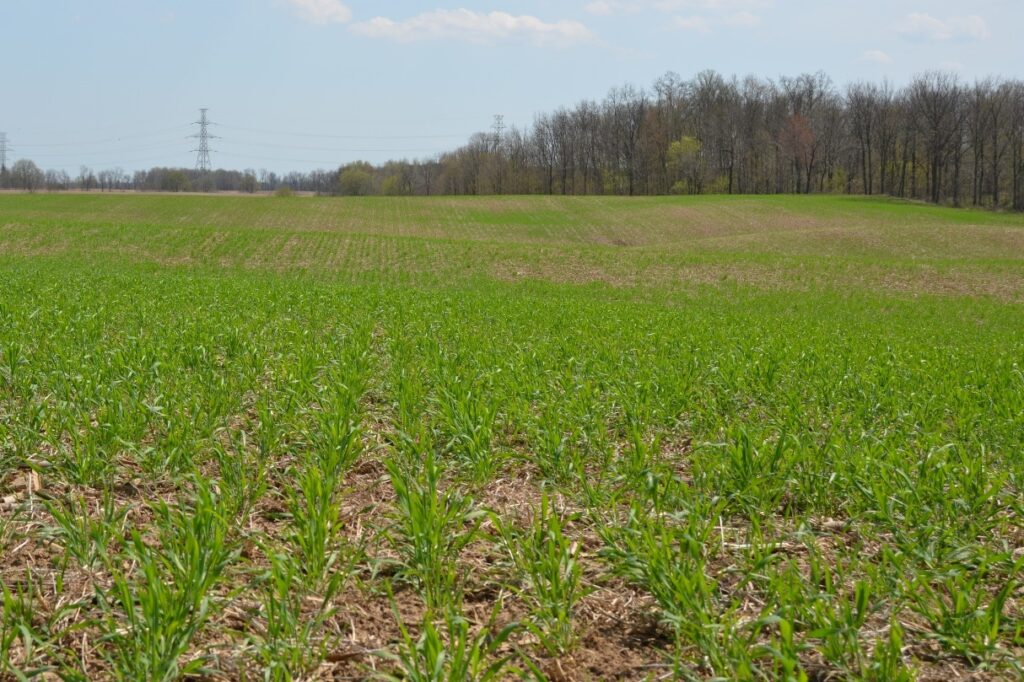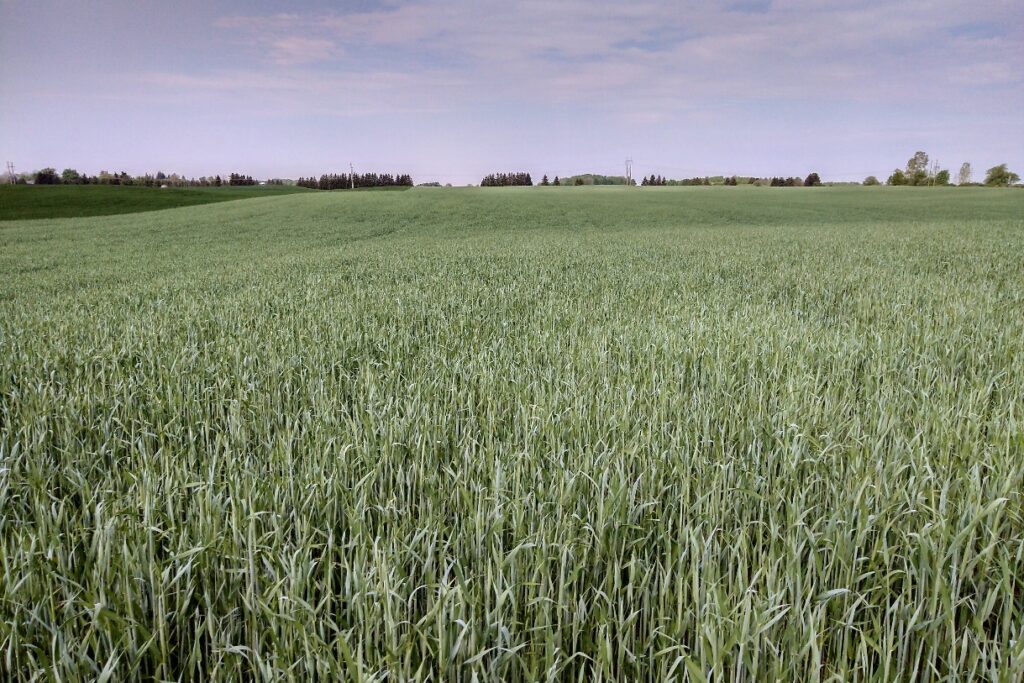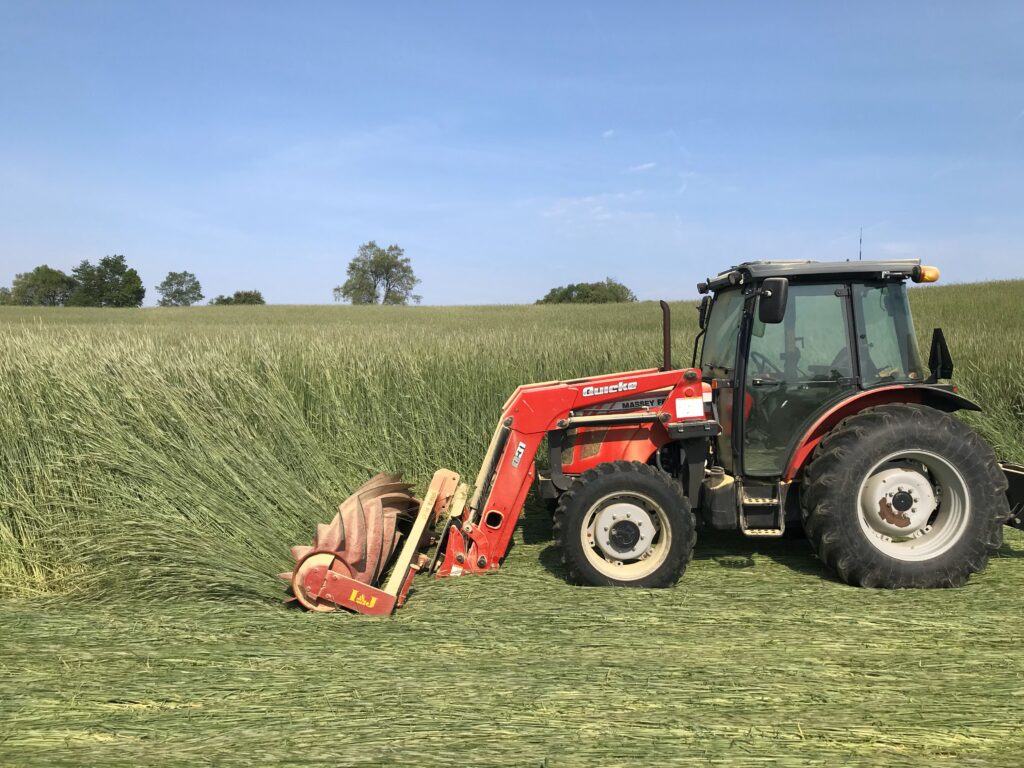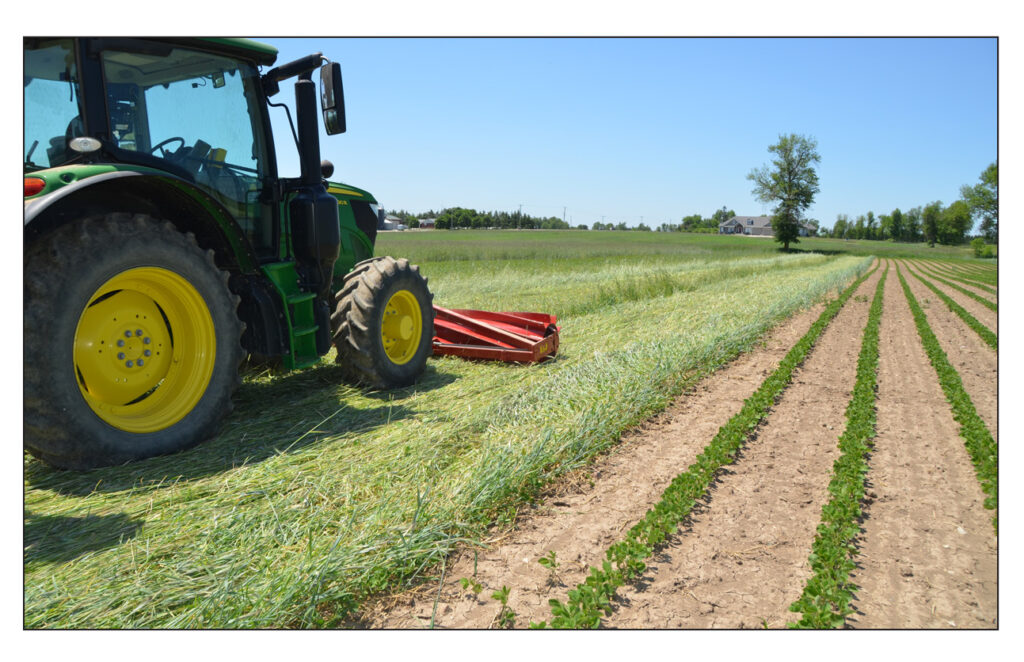Cereal rye (Secale cereale), also known as winter rye or rye – and not to be confused with annual ryegrass (Lolium multiflorum) – is a hardy winter cereal that can be established later in the growing season than any other cover crop (Figure 1). It begins growing earlier in spring than other species and has an extensive root system. Cereal rye performs well in coarse-textured soils and does an excellent job capturing excess soil nitrogen, competing with weeds, and protecting soil from erosion by water and wind. It grows taller and matures earlier than other winter cereals (Figure 2) and is a suitable species for many different applications, ranging from late-season inter-seeding to annual forage production.

Figure 1. Cover crop of cereal rye seeded into soybean stubble.

Figure 2. Cereal rye in mid May in southwestern Ontario.
Establishment and growth
| Germination and emergence | Will germinate in cold temperatures of 0 to 2°C but vegetative growth requires 4°C. |
| Top growth | Taller than wheat (mature crop is 120 to 150 cm in height). Warm, wet weather in May results in rapid growth from 15 cm to 1 m in a short period of time. Early fall seeding and supplemental nitrogen fertility in spring encourages tillering and greater top growth. Flowering (anthesis) typically occurs in first week of June for common cereal rye and is affected by seeding date, heat, and day length. Vegetative growth stops when flowering begins. |
| Root system | Fibrous, extensive root system that has been reported to reach depths of nearly 2 m under favourable soil conditions. |
| Overwintering | Reliably overwinters. Begins spring growth earlier (at lower temperatures) than winter wheat. Can be affected by snow mould when seeded early in the fall and covered by significant snowpack. |
| Site suitability | Tolerates a wide range of soil conditions but does best in well and rapidly drained soils, e.g., loams, sandy loams, and loamy fine sands. More drought tolerant than wheat or oats. |
Common uses in field crop rotations
- Seeded following soybean harvest for soil cover over winter
- Drilled after corn silage or other crops for soil cover or as a spring-harvested forage
- Seeded after grain corn harvest for growth the following spring
- Included in a cover crop mix seeded following small grain harvest in summer
Control options
Herbicides
- Cereal rye can be terminated with glyphosate after the rye begins growing in the spring. Effectiveness and speed of termination improves if rye is rapidly growing and air temperatures are warmer (>15°C).
- Larger rye, rye past the boot stage, or rye sprayed during cooler weather can be more difficult to kill, may require higher glyphosate rates, and will die more slowly.
- Low rates of glyphosate can kill the plant but leave it standing, which prolongs wind erosion and sand-blasting protection. High rates of glyphosate will knock the crop down and provide less wind protection.
Mechanical
- Termination by tillage can be effective, particularly if rye is less than 30 cm (1 foot) when worked under (SARE, 2007). Sufficient time between tillage and seeding of following crop is important.
- Termination by tillage after rye has elongated and is greater than 45 cm (18 inches) tall can result in nitrogen tie-up (SARE, 2007) and residue interference with good seed-to-soil contact.
- Cereal rye can be terminated effectively by mowing or roller crimping (Figure 3) when crop is flowering (at least 50% anthesis). Control is unlikely to be 100% with this method unless supplemented by herbicide application.

Figure 3. Roller crimping cereal rye for termination at full flower.
Benefits and cautions
| Benefits | Cautions | |
| Nutrient management and organic matter | Best cool season cereal crop for taking up leftover nitrogen from previous fertilizer and manure application(s). Rye may help to increase the concentration of potassium at the surface due to its extensive root system. Can return large volumes of above and belowground biomass to the soil and contribute to improved soil organic matter levels. | Can tie up significant quantities of soil nitrogen in spring depending on management. |
| Pest and disease management | Competitive growth habit and release of allelopathic chemicals results in strong suppression of weeds, particularly small-seeded annuals. | Allelopathic chemicals can negatively affect the following crop, particularly for small-seeded plants. Rye can act as a green bridge for diseases like pythium to corn, and in some instances can also be a green bridge for insects such as true armyworm and black cutworm. Termination well in advance of planting a grass crop is recommended. |
| Erosion control | Provides rapid soil cover and extensive root growth to protect against water and wind erosion if seeded early enough in fall. Effective as wind abatement strips (does not winterkill and is resilient to sand blasting). | May not provide adequate erosion protection in zones of concentrated water flow; permanent grassed waterways may be required. Erosion control less if seeded late in season and/or broadcast on soil surface. |
| Soil moisture | More drought tolerant than wheat or oats. Can remove excess soil moisture under wet spring conditions and improve trafficability. | Removes excessive soil moisture under dry conditions when allowed to grow into the stem elongation phase. |
Getting started
- Seed is relatively inexpensive and readily available.
- For best establishment and growth, drill or broadcast and incorporate seed.
- Broadcast seeding is less dependable and requires good rainfall shortly afterward but can be cost-effective and fast.
- Gain experience by growing rye before soybeans as opposed to corn. Terminate it once it is actively growing and 6-12 inches tall or two weeks prior to planting, whichever comes first.
- Cereal rye is shade tolerant and can be an option for late-season inter-seeding into standing soybeans and corn.
Related resources
References
Sustainable Agriculture Research and Education (SARE). Managing Cover Crops Profitably, 3rd Edition. Cereal Rye. 2007. https://www.sare.org/publications/managing-cover-crops-profitably/nonlegume-cover-crops/cereal-rye/. Accessed July 18, 2025.
